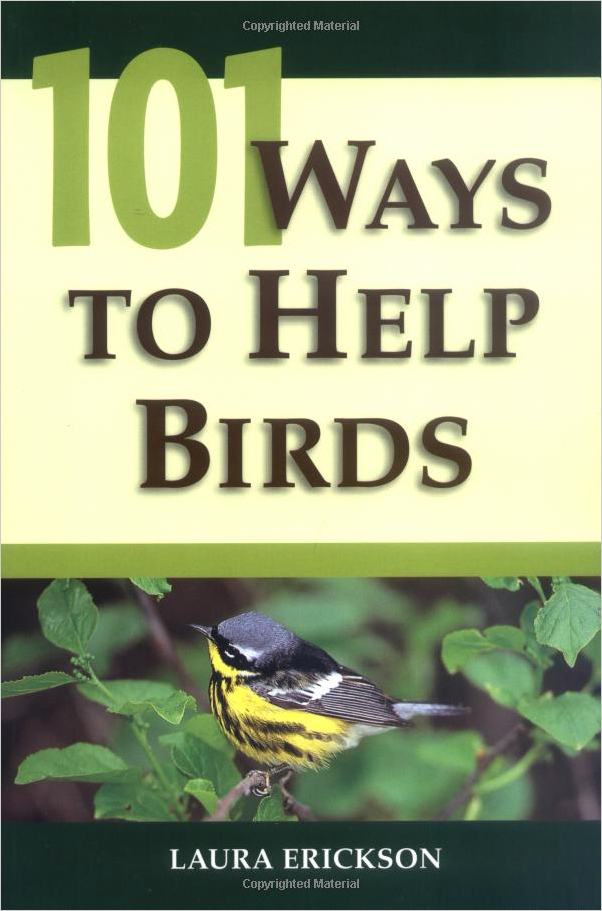One day in the early 1980s when I was out in the backyard with my preschool children, our young golden retriever Bunter brought me a dead Evening Grosbeak. As I reached down to take it, I said, “Oh, Bunter! What did you do?” She looked abashed, but as I took the bird from her, I realized she hadn’t hurt it at all—based on rigor mortis, it had been dead long before she picked it up, killed by our dining room window.
I’d been a birder for 6 years before we moved to Duluth in 1981, but until we got here I had no clue how lethal windows could be. Our dining room picture window was a horrible killer. Evening Grosbeaks and Purple Finches seemed to be the two birds killed most often, but warblers, sparrows, and once a Baltimore Oriole were also among the victims. I’d lose somewhere between 5 and 10 birds every year, a tragic waste, and finding a solution seemed hopeless.
As soon as I started producing “For the Birds” in 1986, I started hearing from listeners with the same problem, making me think more deeply about ways we could prevent collisions. I spent a lot of time researching the issue at the UMD library but didn’t find any tested solutions until 1990, in a paper by Daniel Klem, “Collisions between birds and windows: mortality and prevention” in the Journal of Field Ornithology, based on studies Klem and his students had made on campus at Muhlenberg College.
Klem noted that when feeders were placed directly on windows or set within three feet of the window, birds occasionally hit the glass but weren’t flying fast enough for serious injury, but if the feeders were set any further away, birds hit at maximum velocity. So for Mother’s Day that year, Russ and my kids built a platform feeder directly on our dining room window frame. That marked the end of the problem at that window. Still, one or two birds died at a window somewhere on our house every year.
 |
| About a minute into this video, a young male flies right up to the glass to inspect it. |
Over time, I picked up more ideas from Klem’s work, and put a lot of helpful tips about ways to protect birds from window collisions in my 2006 book, 101 Ways to Help Birds.
Those and more are listed on my website, lauraerickson.com. Click on “Ways to Help” at the top, and then go to #6: “Make your windows safer for birds.”
Suggestions include suspending window screening on the outside of dangerous windows; hanging “zen wind curtains” made from para-cord; creating vertical lines from tape, soap, or waterproof markers no more than 4 inches apart; coating the window with one-way transparent film; and setting taut bird screening 6 or so inches out from the glass so if birds do fly in, they’ll bounce off. Decals on the exterior window surface only work when you cover the window with them, spaced no further apart than a person’s outstretched hand. You can see photos showing most of these in real buildings on my website.
 |
| Audubon's Rowe Sanctuary built this wonderful green welcome/education center overlooking the Platte River in Kearney, Nebraska, where cranes gather. At the building's grand opening, people were horrified by how many birds were crashing into the windows. Fortunately, one of those horrified visitors came up with a great solution, immediately got to work, and then started The Bird Screen Company. |
Window collisions weren’t taken seriously by most scientists despite Daniel Klem’s painstaking research until the past decade, and most prominent bird conservation scientists actually pooh-poohed the significance of the problem. I wish someone like Martha Stewart or the producers of “This Old House” would come up with lovely exterior window coverings that could withstand weather. Why couldn’t we have blinds on tracks on the outside rather than the inside? Or sturdy shutters that open and close securely with an inside control, so it would be easy to keep them closed when we're not enjoying the view? Along the East Coast and Gulf, shutters would also reduce the amount of plywood people buy before hurricanes. And they’d reduce heat loss at night in winter here in the North and keep buildings cooler on sunny days in the South.
Windows kill roughly the same number of birds that cats do—about a BILLION every year in the United States alone. I’m going to be devoting several upcoming programs to the importance of creating bird habitat in our yards. Making our windows safe will help ensure that these birds are not being lured to our homes simply to die.




